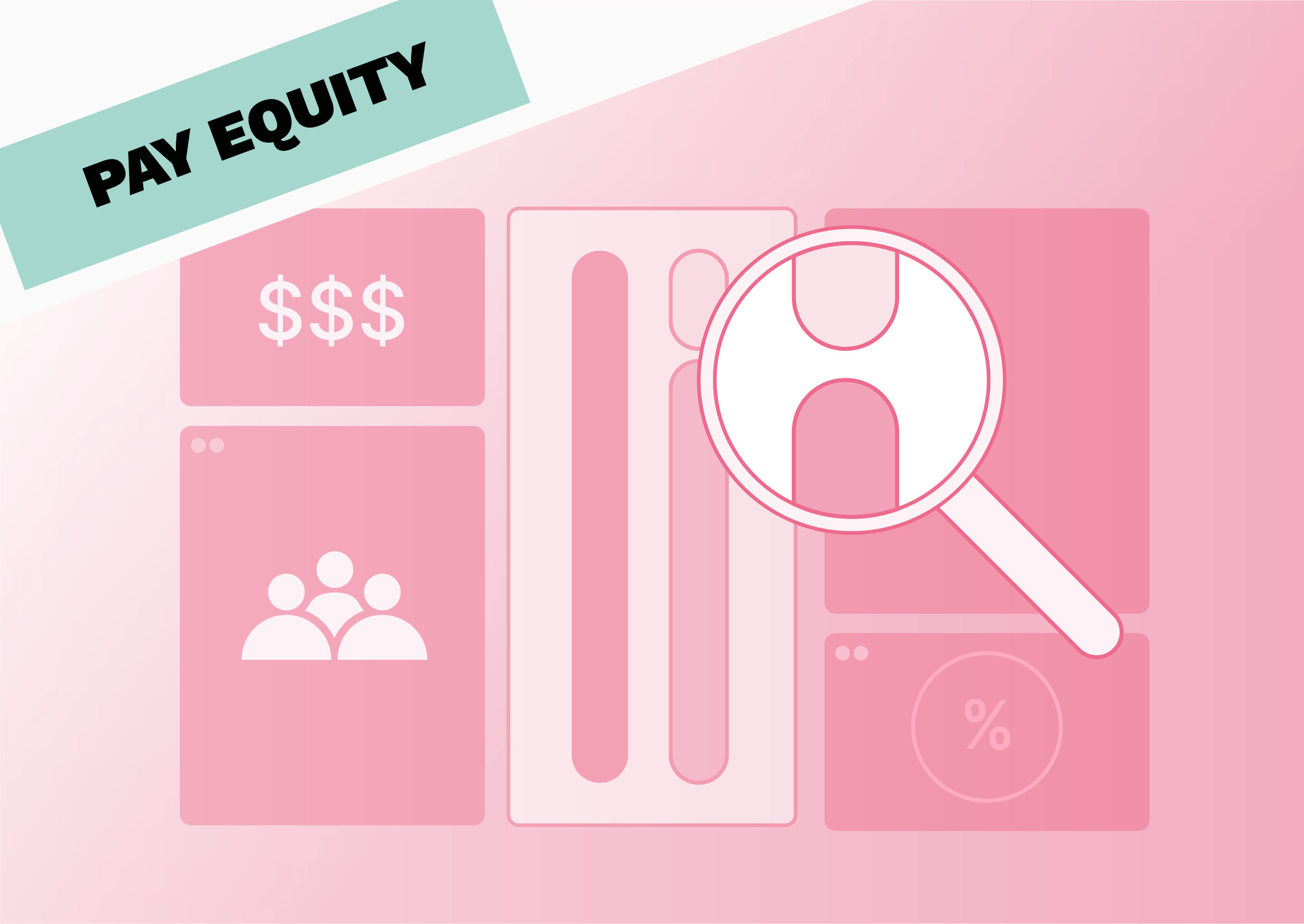There’s no doubt that paying competitive salaries is key to employee engagement and retention. After all, employees aren’t likely to stick around for long if they can make a lot more in the same role somewhere else. But research suggests that pay equity — paying employees fairly regardless of their race, gender or background — might be even more important.
What is pay equity? (And why it matters)
In theory, pay equity is all about one simple concept: equal pay for equal work. That means that employees in the same or similar jobs should get the same salary, bonuses and benefits, regardless of their race, gender, ethnicity, age, religion or other factors that are unrelated to their roles.
Paying people fairly has a ripple effect beyond the wages they take home: employees who are underpaid may struggle to secure loans, build wealth and otherwise improve their circumstances. That means that the negative impact of inequitable pay is much bigger than your organisation.
The link between pay equity and employee engagement and retention
As we’ve said, paying employees competitive salaries is crucial for retention and engagement. But, according to research from The Josh Bersin Company, well-communicated pay equity could be up to thirteen times more impactful.
That’s because pay equity signals to employees that your company values their efforts and contributions. It shows them that they are being treated fairly — and not judged on irrelevant factors like their race, gender, age or sexuality. This leads to more satisfied employees who are more likely to be loyal and committed to you as an employer.
Over time, this can help businesses to improve their reputation, gaining a competitive edge in the talent market. And, because today’s customers increasingly want to buy from ethical, socially responsible companies, it could improve your bottom line too.
The impact of inequitable pay
On the other hand, when employers perceive that pay is inequitable, it can breed feelings of resentment and demotivation. This is understandable: why should an employee give their all to an employer that doesn’t care about paying them fairly?
Ultimately, these underpaid employees are likely to seek other opportunities elsewhere — not just for a bigger paycheck, but for the chance to work in an environment where they feel respected and valued.
This can lead to high turnover rates, which are not only costly for an organisation but can also result in reputational damage and difficulty attracting new talent. It can also have an impact on team cohesion and cause stress for remaining employees as their employer struggles to replace team members who have left.
Other benefits of pay equity for employers
Ensuring employees are compensated equitably is, quite simply, the right thing to do. As we’ve discussed, it can also have a significant impact on employee engagement and retention. Here are some more advantages of pay equity for employers:
- Improves productivity: Employees who feel they are being compensated fairly for their work are much more likely to give it their all. That translates to increased productivity across the organisation.
- Boosts business outcomes: According to Josh Bersin research, companies that are effective in pay equity are 1.6x more likely to exceed financial targets and 1.7x more likely to innovate effectively. Pay equity can lead to better results for your business.
- Increases diversity and inclusion: Employers that demonstrate their commitment to pay equity are more likely to attract diverse talent, which can have a number of benefits. For example, diverse companies benefit from increased profitability and more effective decision-making.
- Mitigates legal issues: In many countries, pay equity is more than just a moral issue. Ensuring compensation is equitable and fair can help businesses to avoid costly legal fees and penalties. For example, Google was recently made to pay $118 million to settle a class action lawsuit claiming it systematically underpaid women in California. Pay equity is also about to become a much bigger focus for employers in Europe, thanks to a new pay transparency directive that will come into force across all member states by 2026.
{{cta}}
A quick guide to improving pay equity in your organisation
Employers that are truly dedicated to equitable pay show their commitment by viewing every decision through a pay equity lens. That means that pay equity is more than just an HR policy. It requires a big cultural shift, which is unlikely to happen overnight.
That said, there are some strategies you can use to take a step or two in the right direction — here are some ideas for improving pay equity in your organisation.
Carry out a pay equity analysis
A pay equity analysis is a systematic audit of an organisation’s compensation systems, policies and processes. They allow employers to identify and quickly correct pay discrepancies and dig into the root causes of inequitable pay. Performing regular analyses can help businesses swiftly resolve problems and prevent inequity from slipping through the cracks.
Establish objective criteria for setting salaries
If you don’t have consistent, pre-set criteria for making pay decisions, pay inequity is almost inevitable. That’s because each manager and recruiter has their own idea of what an employee should be paid — and their own unconscious biases that could impact their decisions. To ensure equitable pay, employers need to make sure that pay decisions are made through fair, gender-neutral and consistent processes — not on the whim of individual managers.
Build a solid compensation structure
Similarly, developing a consistent compensation structure that’s applied equally to all employees could help you stamp out inequitable pay. For example, salary bands provide a consistent framework for pay and progression, helping to standardise pay across an organisation. Salary bands also make it easier to spot any discrepancies quickly — particularly when you use a tool like Figures to automatically highlight any outliers.
Reassess your hiring processes
If you’re still basing new hires’ salaries on their current or previous compensation, you could be contributing to pay inequity. That’s because this practice perpetuates existing pay gaps and makes it impossible for marginalised employees to catch up to their peers. Similarly, allowing for too much negotiation in the hiring process can also lead to inequity, particularly since there’s evidence that women tend to negotiate less than men. Overall, looking at your entire hiring process through a pay equity lens could make a big difference to the state of pay equity in your organisation.
Conduct regular compensation reviews
The annual (or biannual) compensation review is an opportunity to benchmark salaries against the market and award raises to those employees who have earned them. It’s also the moment to perform a general health check on your entire compensation system — including identifying and correcting any pay discrepancies or wider pay gaps.
Invest in the right tools
While many companies see pay equity as an occasional activity to be looked at once a year at most, the reality is that it should be a constant process. Pay equity considerations should run through every decision you make about compensation — and that takes a lot of work.
Thankfully, tools like Figures can make things easier by streamlining compensation processes and giving you all the information you need to make equitable decisions in one place. Figures’ compensation management toolset includes functions for benchmarking salaries against the external market, designing robust, scalable salary band structures and even running compliant and effective compensation reviews.
{{cta}}
The role of pay transparency in improving engagement and retention
For years, compensation has been seen as something private and confidential — but that’s all changing. Many countries around the world have now introduced pay transparency legislation, and an upcoming EU directive will soon introduce new rules across Europe.
As well as being a legal requirement in many places, transparency can help to foster trust and loyalty among a company’s employees. After all, even if your pay practices are 100% equitable and fair, they won’t have much of an impact if they’re kept secret. There’s even evidence that perceptions of equity matter more than actual salaries for improving engagement and retention.
Want to learn more about pay transparency and pay equity? Check out these articles from our archive:
- How Unconscious Bias Impacts Pay Equity (And What to Do About It)
- 5 Signs You Need to Conduct a Compensation Analysis
- Building a Business Case for Pay Transparency: 6 Steps to Follow
- Exploring the Gender Pay Gap in Europe in 2024
- How To Conduct a Pay Equity Analysis (And Why You Should)
- Pay Equity vs Pay Equality: What Is the Difference and Why It Matters
Summarize this article with AI
No time to read it all? Get a clear, structured, and actionable summary in one click.






